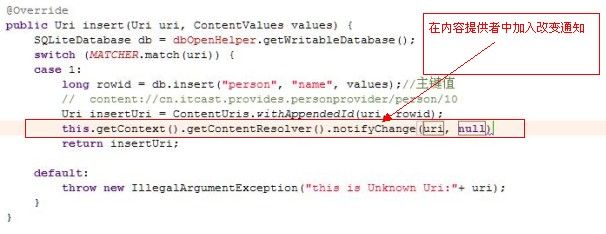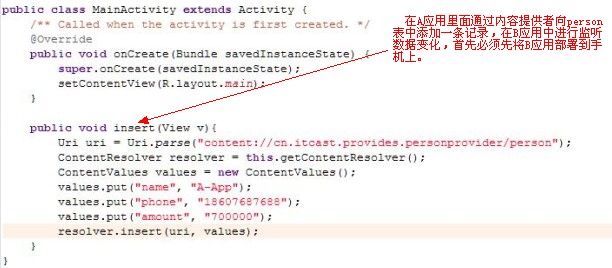Android学习笔记_10_ContentProvider内容提供者的使用
一、使用ContentProvider共享数据
当应用继承ContentProvider类,并重写该类用于提供数据和存储数据的方法,就可以向其他应用共享其数据。以前我们学习过文件的操作模式,通过指定文件的操作模式为Context.MODE_WORLD_READABLE 或Context.MODE_WORLD_WRITEABLE同样可以对外共享数据,但数据的访问方式会因数据存储的方式而不同,如:采用xml文件对外共享数据,需要进行xml解析来读写数据;采用sharedpreferences共享数据,需要使用sharedpreferences API读写数据。而使用ContentProvider共享数据的好处是统一了数据访问方式。
当应用需要通过ContentProvider对外共享数据时,第一步需要继承ContentProvider并重写下面方法:
package com.example.service; import android.content.ContentProvider; import android.content.ContentUris; import android.content.ContentValues; import android.content.UriMatcher; import android.database.Cursor; import android.database.sqlite.SQLiteDatabase; import android.net.Uri; public class PersonProvider extends ContentProvider { private DBOpenHelper helper; // 不匹配返回-1 private static final UriMatcher MATCHER = new UriMatcher( UriMatcher.NO_MATCH); private static final int PERSONS = 1;// 表示多个 private static final int PERSON = 2; // 表示一条记录 static { MATCHER.addURI("com.example.providers.personprovider", "person", PERSONS); MATCHER.addURI("com.example.providers.personprovider", "person/#", PERSON); } // 删除 @Override public int delete(Uri uri, String selection, String[] selectionArgs) { SQLiteDatabase db = helper.getWritableDatabase(); int num = 0; switch (MATCHER.match(uri)) { case 1: num = db.delete("person", selection, selectionArgs); break; case 2: long id = ContentUris.parseId(uri); String where = "id=" + id; if (selection != null && !"".equals(selection.trim())) { where += " and " + selection; } num = db.delete("person", where, selectionArgs); break; default: throw new IllegalArgumentException("uri参数不正确"); } return num; } @Override public String getType(Uri uri) { switch (MATCHER.match(uri)) { case 1: return "vnd.android.cursor.dir/person"; case 2: return "vnd.android.cursor.item/person"; default: throw new IllegalArgumentException("uri参数不正确"); } } @Override public Uri insert(Uri uri, ContentValues values) { SQLiteDatabase db = helper.getWritableDatabase(); switch (MATCHER.match(uri)) { case 1: long rowid = db.insert("person", "name", values); // content://com.example.providers.personprovider/person/1 // Uri insertUri = // Uri.parse("content://com.example.providers.personprovider/person/"+rowid); // 在原来的uri后面加上一个rowid Uri insertUri = ContentUris.withAppendedId(uri, rowid); return insertUri; default: throw new IllegalArgumentException("uri参数不正确"); } } @Override public boolean onCreate() { helper = new DBOpenHelper(this.getContext()); return false; } @Override public Cursor query(Uri uri, String[] projection, String selection, String[] selectionArgs, String sortOrder) { SQLiteDatabase db = helper.getReadableDatabase(); switch (MATCHER.match(uri)) { case 1: return db.query("person", projection, selection, selectionArgs, null, null, sortOrder); case 2: long id = ContentUris.parseId(uri); String where = "id=" + id; if (selection != null && !"".equals(selection.trim())) { where += " and " + selection; } return db.query("person", projection, where, selectionArgs, null, null, sortOrder); default: throw new IllegalArgumentException("uri参数不正确"); } } @Override public int update(Uri uri, ContentValues values, String selection, String[] selectionArgs) { SQLiteDatabase db = helper.getWritableDatabase(); int num = 0; switch (MATCHER.match(uri)) { case 1: num = db.update("person", values, selection, selectionArgs); break; case 2: long id = ContentUris.parseId(uri); String where = "id=" + id; if (selection != null && !"".equals(selection.trim())) { where += " and " + selection; } num = db.update("person", values, where, selectionArgs); break; default: throw new IllegalArgumentException("uri参数不正确"); } return num; } }
第二步需要在AndroidManifest.xml使用<provider>对该ContentProvider进行配置,为了能让其他应用找到该ContentProvider , ContentProvider 采用了authorities(主机名/域名)对它进行唯一标识,你可以把 ContentProvider看作是一个网站(想想,网站也是提供数据者),authorities 就是他的域名:
<manifest> <application android:icon="@drawable/icon" android:label="@string/app_name"> <!-- 配置内容提供者: name:PersonProvider表示内容提供者类名,包名+类。 authorities: 内容提供者的唯一标识 --> <provider android:name="com.example.service.PersonProvider" android:authorities="com.example.providers.personprovider" > </provider>
</application> </manifest>
二、在另一个应用进行测试上面的代码:
需要用到ContentResolver和ContentValues两个类,前者封装了内容提供者的增删改查,后者实体类数据。
package com.example.test; import android.content.ContentResolver; import android.content.ContentValues; import android.database.Cursor; import android.net.Uri; import android.test.AndroidTestCase; import android.util.Log; public class ContentProviderTest extends AndroidTestCase{ public void testInsert(){ Uri uri=Uri.parse("content://com.example.providers.personprovider/person"); ContentResolver resolver = this.getContext().getContentResolver(); ContentValues values = new ContentValues(); values.put("name", "content"); values.put("age", "500"); resolver.insert(uri, values); } public void testUpdate(){ Uri uri=Uri.parse("content://com.example.providers.personprovider/person/150"); ContentResolver resolver = this.getContext().getContentResolver(); ContentValues values = new ContentValues(); values.put("name", "provider"); values.put("age", "50"); resolver.update(uri, values, null, null); } public void testDelete(){ Uri uri=Uri.parse("content://com.example.providers.personprovider/person/150"); ContentResolver resolver = this.getContext().getContentResolver(); resolver.delete(uri, null, null); } public void testQuery(){ Uri uri=Uri.parse("content://com.example.providers.personprovider/person"); ContentResolver resolver = this.getContext().getContentResolver(); Cursor cursor = resolver.query(uri, null, null, null, null); while (cursor.moveToNext()) { String name = cursor.getString(cursor.getColumnIndex("name")); int age = cursor.getInt(cursor.getColumnIndex("age")); Log.i("ContentProviderTest", " "+name+" : "+age); } } }
三、Uri介绍
Uri代表了要操作的数据,Uri主要包含了两部分信息:1》需要操作的ContentProvider ,2》对ContentProvider中的什么数据进行操作,一个Uri由以下几部分组成:
content://com.example.providers.personprovider/person/10,其中“com.example.providers.personprovider”指主机名或authority,“person/10”表示路径。
ContentProvider(内容提供者)的scheme已经由Android所规定, scheme为:content:// 主机名(或叫Authority)用于唯一标识这个ContentProvider,外部调用者可以根据这个标识来找到它。 路径(path)可以用来表示我们要操作的数据,路径的构建应根据业务而定,如下: 要操作person表中id为10的记录,可以构建这样的路径:/person/10 要操作person表中id为10的记录的name字段, person/10/name 要操作person表中的所有记录,可以构建这样的路径:/person 要操作xxx表中的记录,可以构建这样的路径:/xxx 当然要操作的数据不一定来自数据库,也可以是文件、xml或网络等其他存储方式,如下: 要操作xml文件中person节点下的name节点,可以构建这样的路径:/person/name 如果要把一个字符串转换成Uri,可以使用Uri类中的parse()方法,如下: Uri uri = Uri.parse("content://cn.itcast.provider.personprovider/person")
四、监听内容提供者的数据变化:
1、对提供内容提供者的应用加入改变通知:
package cn.itcast.db; import cn.itcast.service.DBOpenHelper; import android.content.ContentProvider; import android.content.ContentUris; import android.content.ContentValues; import android.content.UriMatcher; import android.database.Cursor; import android.database.sqlite.SQLiteDatabase; import android.net.Uri; public class PersonContentProvider extends ContentProvider { private static UriMatcher matcher = new UriMatcher(UriMatcher.NO_MATCH); private static final int PERSONS = 1; private static final int PERSON = 2; private DBOpenHelper dbOpenHelper; static{ matcher.addURI("cn.itcast.providers.personprovider", "person", PERSONS); matcher.addURI("cn.itcast.providers.personprovider", "person/#", PERSON); } @Override public boolean onCreate() { dbOpenHelper = new DBOpenHelper(this.getContext()); return true; } @Override public int delete(Uri uri, String selection, String[] selectionArgs) { SQLiteDatabase db = dbOpenHelper.getWritableDatabase(); int num = 0 ;//已经删除的记录数量 switch (matcher.match(uri)) { case PERSONS: num = db.delete("person", selection, selectionArgs); break; case PERSON: long id = ContentUris.parseId(uri); String where = "personid="+ id; if(selection!=null && !"".equals(selection)){ // personid=12 and name=? where = where + " and "+ selection; } num = db.delete("person", where, selectionArgs); break; default: throw new IllegalArgumentException("Unkown Uri:"+ uri); } getContext().getContentResolver().notifyChange(uri, null); return num; } @Override public String getType(Uri uri) {//返回当前操作的数据类型 switch (matcher.match(uri)) { case PERSONS://操作的是集合类型数据 return "vnd.android.cursor.dir/person"; case PERSON: return "vnd.android.cursor.item/person"; default: throw new IllegalArgumentException("Unkown Uri:"+ uri); } } @Override public Uri insert(Uri uri, ContentValues values) { SQLiteDatabase db = dbOpenHelper.getWritableDatabase(); long id = 0 ; switch (matcher.match(uri)) { case PERSONS: id = db.insert("person", "personid", values);//得到记录的id getContext().getContentResolver().notifyChange(uri, null); return ContentUris.withAppendedId(uri, id);//返回代表新增记录的Uri case PERSON: id = db.insert("person", "personid", values);//得到记录的id String strUri = uri.toString(); Uri personUri = Uri.parse(strUri.substring(0, strUri.lastIndexOf("/"))); getContext().getContentResolver().notifyChange(personUri, null); return ContentUris.withAppendedId(personUri, id); default: throw new IllegalArgumentException("Unkown Uri:"+ uri); } } @Override public Cursor query(Uri uri, String[] projection, String selection, String[] selectionArgs, String sortOrder) { SQLiteDatabase db = dbOpenHelper.getReadableDatabase(); switch (matcher.match(uri)) { case PERSONS: return db.query("person", projection, selection, selectionArgs, null, null, sortOrder); case PERSON: long id = ContentUris.parseId(uri); String where = "personid="+ id; if(selection!=null && !"".equals(selection)){ // personid=12 and name=? where = where + " and "+ selection; } return db.query("person", projection, where, selectionArgs, null, null, sortOrder); default: throw new IllegalArgumentException("Unkown Uri:"+ uri); } } @Override public int update(Uri uri, ContentValues values, String selection, String[] selectionArgs) { SQLiteDatabase db = dbOpenHelper.getWritableDatabase(); int num = 0 ;//已经修改的记录数量 switch (matcher.match(uri)) { case PERSONS: num = db.update("person", values, selection, selectionArgs); break; case PERSON: long id = ContentUris.parseId(uri); String where = "personid="+ id; if(selection!=null && !"".equals(selection)){ where = where + " and "+ selection; } num = db.update("person", values, where, selectionArgs); break; default: throw new IllegalArgumentException("Unkown Uri:"+ uri); } getContext().getContentResolver().notifyChange(uri, null);//通知数据发生变化 return num; } }
2、注册要通知改变的uri,启动B应用:
3、执行添加方法:


